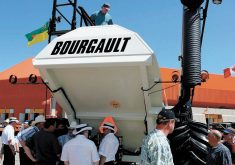Reuters / Thousands of Pashmina goats may have perished in recent heavy snowfall around the nomadic areas of Changthang on the Sino-Indian frontier of the Ladakh region, officials said Feb. 22.
The area is a production hub for the finest quality of Pashmina (Kashmir) wool in India and is used in manufacturing of popular Kashmiri shawls sold across the world.
“We have no information of several places in the area. Many places are still snowbound and inaccessible. There is no communication link with them,” said Tsering Samphel, a former lawmaker from the region.
Read Also

Pig transport stress costs pork sector
Popular livestock trailer designs also increase pig stress during transportation, hitting at meat quality, animal welfare and farm profit, Agriculture and Agri-Food Canada researcher says
“Since 1962, this is an unprecedented snowfall in the area and it has severely affected our nomadic way of life and livestock. Pashmina goats who get impregnated before the onset of winter have also perished,” he added.
“We may face (an) acute shortage of Pashmina wool this year.”
He said up to 10,000 domesticated animals including Pashmina goats have perished due to fodder shortages and the freezing cold.
“About 1,000 quintals (100,000 kg) of fodder were dispatched immediately by Ladakh Autonomous Hill Development Council (LAHDC) to the affected areas but the same could not be distributed due to snowbound pastures where these animals are scattered these days,” said Samphel.
He said the federal Ministry of Textiles had earmarked 40 million rupees last year for nutrition supplement to save Pashmina goats during pregnancy and to meet such exigencies.
This money, Samphel said, helped in procuring about 10,000 quintals of cattle feed, 2,500 quintals of barley and 3,000 quintals of alfalfa fodder for the purpose.


















